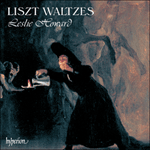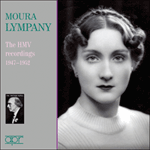
Welcome to Hyperion Records, an independent British classical label devoted to presenting high-quality recordings of music of all styles and from all periods from the twelfth century to the twenty-first.
Hyperion offers both CDs, and downloads in a number of formats. The site is also available in several languages.
Please use the dropdown buttons to set your preferred options, or use the checkbox to accept the defaults.
The first Mephisto Waltz, the only one that follows the event at the village inn in detail, begins with a characteristically devilish outrage of convention as Mephistopheles tunes his violin and Liszt piles fifth upon fifth into a harmonic accretion that must have seemed a howling dissonance to his contemporaries. The music Mephisto plays to the villagers is as uninhibited as his preparation for it. His turbulent and unstoppable dance most effectively offsets the central theme of the work, a contrastingly sensitive and hesitantly syncopated but highly erotic waltz tune, marked espressivo amoroso. A seductive of D flat major waltzes, it is awarded to Faust himself to further his enterprise in the wood outside. After an extended and beautifully scored virtuoso development, Faust’s waltz tune is combined at the climax of the construction with allusions to the first theme and driven into an infernal gallop. The voice of the nightingale is heard in poetic isolation just before the rumbling onset of a short but dramatic coda.
from notes by Gerald Larner © 2009
La première Méphisto-Valse, la seule qui reprend en détails l’épisode à l’auberge villageoise, s’ouvre sur un outrage, typiquement diabolique, des usages, lorsque Méphistophélès accorde son violon et que Liszt empile les quintes en une accumulation harmonique qui a dû paraître, à l’époque, une énorme dissonance. Méphisto joue aux villageois une musique aussi désinhibée que la manière dont il s’est préparé à la jouer. Sa danse turbulente, irrépressible, contrebalance très efficacement le thème central de l’œuvre, un air de valse sensible et timidement syncopé mais très érotique, marqué espressivo amoroso. Cette valse, la plus séduisante de toutes celles en ré bémol majeur, récompense Faust en lui permettant de se montrer toujours plus entreprenant, dans les bois. Après un développement virtuose étendu et merveilleusement écrit, l’air de valse faustien est combiné, au summum de la construction, avec des allusions au premier thème, et poussé vers un galop infernal. On entend la voix du rossignol dans un poétique isolement, juste avant le départ d’une courte mais saisissante coda.
extrait des notes rédigées par Gerald Larner © 2009
Français: Hypérion
Der erste Mephisto-Walzer ist der einzige, in dem das Geschehen in der Dorfschenke genau nachgezeichnet wird und er beginnt mit einem charakteristisch teuflischen Bruch der Konventionen, wenn Mephistopheles seine Geige stimmt und Liszt in einem harmonischen Anwachsen die Quinten nur so aufeinanderstapelt, dass es für seine Zeitgenossen wie eine heulende Dissonanz geklungen haben muss. Die Musik, die Mephisto den Dorfbewohnern vorspielt, ist ebenso zügellos wie seine Vorbereitung darauf. Sein turbulenter und unaufhaltsamer Tanz bildet einen besonders wirkungsvollen Kontrast zu dem Hauptthema des Werks, eine sanftmütige und zögerlich synkopierte, aber doch sehr erotische Walzermelodie, die mit espressivo amoroso überschrieben ist. Es ist dies von allen Walzern in Des-Dur, der verführerischste und er ist Faust selbst gewidmet, der seinen Machenschaften im Wald nachgeht. Nach einer ausgedehnten und kunstvoll gesetzten virtuosen Durchführung wird Fausts Walzermelodie auf dem Höhepunkt des Werks mit Anspielungen an das erste Thema kombiniert und geht dann in einen dämonischen Galopp über. Die Stimme der Nachtigall erklingt noch einmal in poetischer Abgeschiedenheit, kurz bevor ein Grummeln eine kurze aber dramatische Coda ankündigt.
aus dem Begleittext von Gerald Larner © 2009
Deutsch: Viola Scheffel
 Liszt: Complete Piano Music Liszt: Complete Piano MusicLeslie Howard’s recordings of Liszt’s complete piano music, on 99 CDs, is one of the monumental achievements in the history of recorded music. Remarkable as much for its musicological research and scholarly rigour as for Howard’s Herculean piano p ...» More |
 Liszt: The complete music for solo piano, Vol. 1 - Waltzes Liszt: The complete music for solo piano, Vol. 1 - Waltzes‘For sheer virtuosic panache and the ability to translate Liszt's ever-changing moods, Leslie Howard must be heard’ (Hi-Fi News)» More |
 Moura Lympany - The HMV Recordings, 1947-1952 Moura Lympany - The HMV Recordings, 1947-1952Moura Lympany (1916-2005) was the last of the major Matthay pupils and she started working with him in 1937 when he was already 79. In 1938 she shot to international fame when she came second to Emil Gilels in the Queen Elisabeth competition. A br ...» More |

